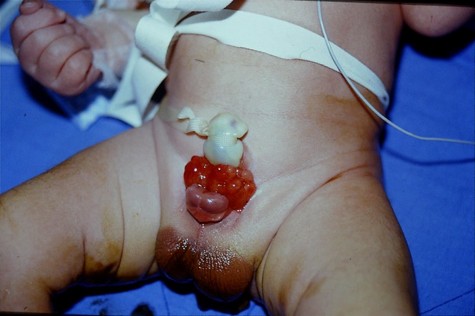[MIM 258 040, 600 057] Occurs in approximately 1/50 000 births with a strong male predominance (3/1).
Bladder exstrophy is the result of an abnormal development of the cloacal membrane that divides the cloaca in an anterior urogenital portion and a posterior anorectal portion.
The extent of the damage is variable and can be classified into different more or less severe anatomical forms:
- isolated epispadias, resulting from a relatively small breakdown of the cloacal membrane, just in front of the genital tubercle;
- full bladder exstrophy, consequence of a large breakdown of the urogenital membrane reaching the umbilicus (often absent) and leading into an absence of fusion:
- of the rectus abdominis muscles
- of the pubic rami (symphysis)
- and more or less completely, of the cavernous body leading to a malformation of the external male (at least short penis, maximally epispadias, even double penis) as female genitalia (epispadias of urethra, surrounded by a bifid clitoris; divergent labia);
- minor forms known "bladder exstrophy variations", less frequent and mostly encountered in female; they result from a small incomplete rupture of the urogenital membrane that may be the cause of:
- a bifid bladder
- a (lower or upper) bladder split,
- a bladder exstrophy without fissure (normal bladder under the bladder plate)
- an exstrophy of one of the two bladders in case of bifid bladder;
- exstrophy limited to the posterior wall of the bladder, resulting from a late breakdown of the cloacal membrane (the terminal bowel is then intact);
- cloacal exstrophy presentinng as an intestinal middle part surrounded by two lateral bladder layers: it results from an early breakdown of the cloacal membrane (before the partitioning of the cloaca): prevalence is around 1/200,000 to 1/400,000 births. It is often associated with vertebral malformations (spina bifida occulta, hemivertebrae), malformations of the limbs (dislocation of hip, clubfoot) or intestinal malformations (malrotation, short bowel).

bladder exstrophy in a boy
The bladder exstrophy does not require emergency surgical correction of the lesions as in case of omphalocele or gastroschisis. However, as soon as possible after birth, the exposed region must be covered with sterile gauze and antiobioprophylaxis must be started.
The treatment of bladder exstrophy is a complex procedure and requires several operating stages:
- early bladder closure associated with the closure of the abdominal wall with alignment of the pubic rami (an iliac osteotomy by the anterior/obturator or posterior route may be necessary): this intervention is usually carried out as an emergency procedure during the early neonatal period (< 72 hours to avoid the iliac osteotomy if feasible), but is currently performed electively around 8-10 weeks of life (Erlangen procedure) or even several months later in some centres (in these cases the cure of the exstrophy, the epispadias and the bladder neck can be performed at the same time). The obturator osteotomy avoids the need for an external fixator on the pelvic bones
- followed, when the bladder capacity is at least 85 ml, by reconstruction of the sphincter mechanism of the bladder neck (Young-Dees procedure) and cure of the vesicoureteral reflux (ureteral reimplantation); if the bladder capacity is not sufficient a bladder enlargement plasty is performed
- sometimes, internal (ureterosigmoidostomy, ureterocolic implantation) or external (cutaneous ureterostomy, transintestinal ureteral derivations) ureteral derivations have to be carried out;
- repair of the external genitalia.
In case of isolated epispadias: cure as a hypospadias.
In minor forms: elective care in childhood.
Exstrophy limited to the posterior bladder wall is often uncovered during the course of the correction of an apparently complete exstrophy.
Anesthetic implications:
- neonatal anesthesia: presence of a permeable ductus arteriosus and foramen oval (pre-and post-ductal saturation monitoring), high pulmonary pressures, risk of hypothermia and hypoglycemia
- latex allergy prevention: the risk of developing a latex allergy is a major risk
- bleeding associated at the time of the iliac osteotomies
- possible problem of double surgical route (bladder and rectum) with complete peroperative repositioning in case of cloacal exstrophy
- peripheral venous access, arterial catheter + central venous catheter
- in the absence of lumbosacral anomalies, caudal or continuous lumbar epidural analgesia facilitates the mobilisation of the child and its postoperative analgesia
References :
- Ebert AK, Reutter H, Ludwig M, Rösch WH.
The exstrophy-epispadias complex.
Orphanet J Rare Dis 2009; 4:23 (17 p)
- Woo LL, Thomas JC, Brock JW.
Cloacal exstrophy: A comprehensive review of an uncommon problem.
J Pediatr Urol 2010; 6(2):102-111
- Kiddoo DA, Carr MC, Dulczak S, Canning DA.
Initial management of complex urological disorders: bladder exstrophy.
Urol Clin North Am 2004; 31:417-26.
- Wee L, Stokes MA.
Bladder exstrophy in a neonate at risk for transient myasthenia gravis: a role for remifentanil and epidural analgesia.
Br J Anaesth 1999; 82: 774-6.
- Kost-Byerly S, Jackson EV, Yaster M, Korzlowski LJ et al.
Perioperative anesthetic and analgesic management of newborn bladder exstrophy repair.
J Pediatr Urol 2008; 4: 280-5.
- El Gohary MA.
Duplicate bladder exstrophy: a case report.
J Pediatr Urol 2008; 4: 310-2.
- Kibar Y, Roth CC, Frimberger D, Kropp BO.
Our initial experience with the technique of complete repair for bladder exstrophy.
J Pediatr Urol 2009; 5: 186-9.
- Massanyi EZ, Gearhart P, Kost-Byerly S.
Perioperative management of bladder exstrophy.
Research & Reports in Urology 2013; 5: 67- 73.
- Farid IS1, Kendrick EJ, Adamczyk MJ, Lukas NR, Massanyi EZ.
Perioperative analgesic management of newborn bladder exstrophy repair using a directly placed tunneled epidural catheter with 0.1% ropivacaine.
A& A Case Rep. 2015; 5:112-4
- Faraj S, Decante C, Alliot H, Hamel A, Leclair M-D.
Bilateral obturator osteotomy: a novel osteotomy for bladder exstrophy closure.
J Pediatr Surg 2024; 59:1841-5,
Updated: September 2024